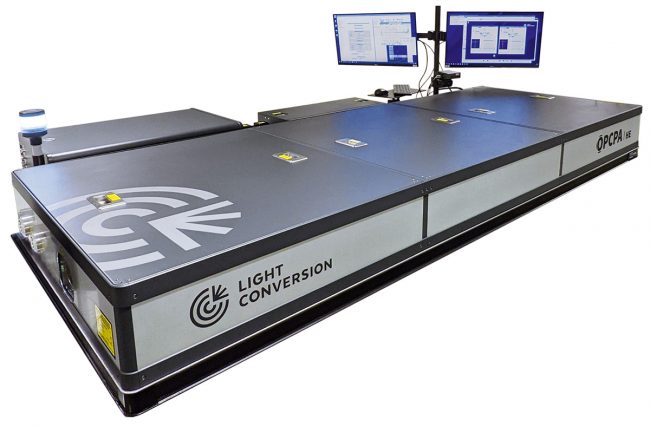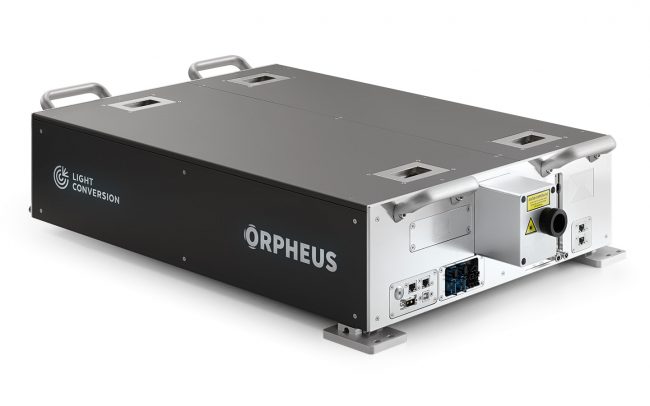One of the most sophisticated and intriguing applications of high-energy femtosecond pulses is the process of high harmonic generation (HHG). By focusing intense laser pulses into a gas target, one can generate much higher-order harmonics than what is possible with conventional solid-state nonlinear materials, extending well into the extreme ultraviolet (EUV) or even soft X-ray range. At the same time, thanks to the broad bandwidth and short wavelength, the resulting pulses may even reach the attosecond scale.
In general, the HHG process can be described with a simplified semi-classical three-step model. First, an intense laser field temporally suppresses the Coulomb potential of an atom. Then, an electronic wave packet can tunnel into the continuum and is accelerated by the driving laser field. When the driving laser field reverses, the electronic wave packet is pulled back to the atomic core to interfere with the residual bound electronic wave packet in the ground state of the system. The interference results in a burst of coherent photons with photon energies from tens to thousands of electronvolts (eV). Since this process is repeated every half-cycle of the laser field, interference between consecutive pulses results in odd high-order harmonics of the fundamental frequency and, in the time-domain, an attosecond pulse train.
HHG typically requires laser intensities on the order of 1014 W/cm2 to distort the Coulomb potential and allowing the electron to tunnel out and get accelerated to high energies. Such fields are usually obtained by high-peak-power systems, such as optical parametric chirped-pulse amplification (OPCPA) systems. Though, HHG has also been demonstrated using direct fundamental radiation from PHAROS and CARBIDE femtosecond lasers. In any case, Yb-based laser sources are of high interest because of their high repetition rates. Traditionally, HHG has been limited to low pulse repetition rates, not exceeding a few kHz. However, many scientific applications using HHG could benefit from higher repetition rates. For example, time-resolved photoemission spectroscopy is limited in the number of emitted photoelectrons per pulse by charge effects, and therefore, the statistics can be improved only by operating at higher repetition rates. The generation of high harmonics at 100 kHz repetition rate has been reported using PHAROS femtosecond laser and focusing its radiation in both gas chamber and capillary geometries; see the publication by E. Lorek et al. and KMLabs newsletter, respectively.
Table-top solutions for the generation of ultrafast, high repetition rate, and coherent EUV light enable cutting-edge experiments, previously possible only at large-scale synchrotron facilities. The availability, reliability, and stability of HHG sources are bound to improve using compact and user-friendly laser systems provided by LIGHT CONVERSION.
- 高达 1 kHz 的 TW 级峰值功率脉冲
- 800 nm、1600 nm 或 2000 nm 输出
- 少周期的脉宽和高前脉冲对比度
- 设计坚固,预热时间<1小时
- 卓越的 CEP 和脉冲能量稳定性
- 少周期脉冲,结构紧凑,占地面积小
- 800 nm、1600 nm、2000 nm 或 3000 nm 输出
- 高达MHz的重复频率
- 高对比度种子源,适用于 CPA 和 OPCPA 系统
- 卓越的功率、脉冲能量和 CEP 稳定性
- SH/TH 可选
- 高重复频率下的宽带中红外脉冲
- 2500 – 15000 nm 连续可调
- 波长 2000 nm 短脉冲高能量输出
- 工业级激光器泵浦,稳定性高
- 可选配 CEP 稳定
- 100 fs – 20 ps 连续可调脉宽
- 最大单脉冲能量 4 mJ
- 最小脉宽输出 < 100 fs
- POD 和 BiBurst 功能
- 高达 5 次谐波或可调谐扩展
- CEP 稳定或重复频率锁定
- 热稳定性和密封设计
- 190 fs – 20 ps 连续可调脉宽
- 最大输出 1 mJ @ 120 W 或 2 mJ @ 80 W
- 单脉冲 – 2 MHz 重复频率
- POD 和 BiBurst 功能
- 高达 5 次谐波或可调谐扩展
- 风冷型号
- 紧凑的工业级设计
Coherent narrowband light source for ultrafast photoelectron spectroscopy in the 17–31 eV photon energy range
R. Cucini, T. Pincelli, G. Panaccione, D. Kopic, F. Frassetto, P. Miotti, G. M. Pierantozzi, S. Peli, A. Fondacaro, A. D. Luisa et al., Structural Dynamics 1 (7), 014303 (2020).
Extreme ultraviolet time- and angle-resolved photoemission setup with 21.5 meV resolution using high-order harmonic generation from a turn-key Yb:KGW amplifier
Y. Liu, J. E. Beetar, M. M. Hosen, G. Dhakal, C. Sims, F. Kabir, M. B. Etienne, K. Dimitri, S. Regmi, Y. Liu et al., Review of Scientific Instruments 1 (91), 013102 (2020).
High resolution time- and angle-resolved photoemission spectroscopy with 11 eV laser pulses
C. Lee, T. Rohwer, E. J. Sie, A. Zong, E. Baldini, J. Straquadine, P. Walmsley, D. Gardner, Y. S. Lee, I. R. Fisher et al., Review of Scientific Instruments 4 (91), 043102 (2020).
Multioctave supercontinuum generation and frequency conversion based on rotational nonlinearity
J. E. Beetar, M. Nrisimhamurty, T. Truong, G. C. Nagar, Y. Liu, J. Nesper, O. Suarez, F. Rivas, Y. Wu, B. Shim et al., Science Advances 34 (6), eabb5375 (2020).
High-harmonic generation from an epsilon-near-zero material
Y. Yang, J. Lu, A. Manjavacas, T. S. Luk, H. Liu, K. Kelley, J. Maria, E. L. Runnerstrom, M. B. Sinclair, S. Ghimire et al., Nature Physics 10 (15), 1022-1026 (2019).
Symmetry and Polarization of High-Order Harmonic Generation from Solids
S. Gholam‑Mirzaei, S. Jiang, E. Crites, J. E. Beetar, R. Lu, C. D. Lin, and M. Chini, in Conference on Lasers and Electro-Optics, (OSA, 2019).
Evidence for topological defects in a photoinduced phase transition
A. Zong, A. Kogar, Y. Bie, T. Rohwer, C. Lee, E. Baldini, E. Ergeçen, M. B. Yilmaz, B. Freelon, E. J. Sie et al., Nature Physics 1 (15), 27-31 (2018).
Extreme–ultraviolet high–harmonic generation in liquids
T. T. Luu, Z. Yin, A. Jain, T. Gaumnitz, Y. Pertot, J. Ma, and H. J. Wörner, Nature Communications 1 (9) (2018).
High-harmonic generation in ZnO driven by self-compressed mid-infrared pulses
S. Gholam‑Mirzaei, J. E. Beetar, A. Chacón, and M. Chini, Journal of the Optical Society of America B 4 (35), A27 (2018).
Interferometry of dipole phase in high harmonics from solids
J. Lu, E. F. Cunningham, Y. S. You, D. A. Reis, and S. Ghimire, Nature Photonics 2 (13), 96-100 (2018).





